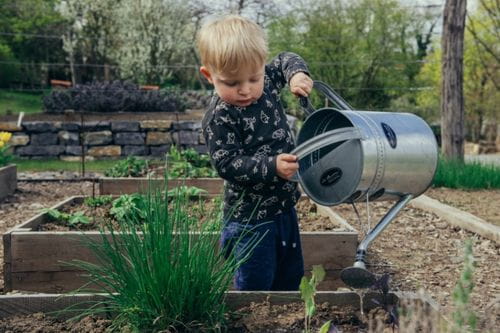Digging In: The Essential Master Gardening Tools for Beginners
Wiki Article
From Seed to Grow: A Newbie's Guide to Gardening Success

Choosing the Right Seeds
To make sure a successful yard, you require to select the best seeds for your expanding conditions and desired plants. Various plants prosper in different environments, so it's essential to choose seeds that are ideal for your certain region. On the other hand, if you live in a cooler environment with shorter growing periods, look for seeds that have a much shorter maturation period.Some plants prefer sandy dirt, while others thrive in clay or loamy soil. Some plants, like peppers and tomatoes, need complete sun to prosper, while others, such as leafy environment-friendlies, can endure partial color.
If you're interested in blossoms, pick seeds for plants that will enhance each various other in terms of color, blossom, and elevation time. By thoroughly picking the ideal seeds for your growing problems and preferred plants, you'll set yourself up for an effective garden.
Preparing the Dirt
Currently that you've picked the best seeds for your yard, it's time to prepare the soil for ideal growth. Preparing the soil is a critical action in horticulture success, as it supplies the structure for your plants to flourish.Beginning by eliminating any kind of weeds or debris from the location where you prepare to plant (home gardening for beginners). Weeds can contend with your plants for nutrients and water, so it's essential to obtain rid of them before growing. Utilize a yard fork or hoe to loosen the soil, damaging up any kind of clumps and producing a loosened, crumbly texture
Following, it's time to boost the soil's fertility. Add natural issue, such as garden compost or well-rotted manure, to enrich the dirt and give necessary nutrients. Spread out a layer of raw material over the soil and make use of a garden fork or rake to integrate it right into the leading few inches. This will certainly help boost drain, wetness retention, and nutrient schedule for your plants.
Lastly, take into consideration testing your soil's pH level. Most plants choose a somewhat acidic to neutral pH, around 6.0 to 7.0. You can acquire a dirt screening package from a garden center or send a sample to a lab for analysis. Based upon the outcomes, you can change the pH degree by including amendments like lime or sulfur.
Planting and Watering Strategies
After preparing the soil, it's time for you to concentrate on growing and sprinkling techniques to guarantee the success of your garden. Make sure to comply with the directions on the seed packages or plant tags when it comes to growing. Various plants have various demands for planting deepness and spacing. Dig a hole that is just the right dimension for the plant's roots and gently place it in, making certain not to harm the roots. Fill the hole with dirt, carefully firming it around the plant.Watering is a critical action in gardening. It is very important to water your plants effectively to promote healthy and balanced development. The key is to supply enough water gardening tools for beginners without sinking the plants. When watering, objective to dampen the soil equally, making sure that the water reaches the plant's origins. Avoid overwatering, as this can bring about root rot and other problems. A great guideline is to water deeply however less regularly, enabling the soil to dry somewhat between watering sessions.
To figure out when to water, check the dampness level of the dirt by putting your finger regarding an inch deep. If it feels completely dry, it's time to water. Take into consideration utilizing a watering can or a tube with a gentle spray nozzle to avoid destructive delicate plants.
Nurturing and Preserving Your Garden
Supporting and maintaining your yard is important in order to keep your plants healthy and balanced and successful. On a regular basis eliminate any kind of unwanted plants that might contend with your garden for nutrients and room. Applying a layer of compost around your plants aids preserve wetness, subdue weeds, and regulate dirt temperature.Harvesting and Enjoying the Fruits of Your Labor
When can you start enjoying the rewards of your tough job in the garden? The response depends on the type of plants you have expanded.To establish if your vegetables are all set for harvest, you need to look for certain signs. They must quickly remove from the creeping plant when gently pulled.
When harvesting, it is necessary to utilize the proper devices and techniques. A sharp pair of pruning shears or a yard blade can be utilized to cleanly cut vegetables from the plant. Be certain to harvest in the early morning when the temperature levels are cooler, as this will certainly aid keep the quality of your fruit and vegetables.
As soon as you have actually harvested your vegetables, it's time to enjoy the fruits of your labor. Freshly selected veggies can be made use of in a selection of scrumptious recipes, from salads to stir-fries. Conversely, you can maintain your harvest by canning, cold, or drying them to take pleasure in throughout the year.

Verdict
By adhering to these beginner-friendly methods, you are well on your means to nurturing a thriving garden. Keep in mind to offer your plants the care and focus they need, and soon you will certainly be delighting in the beauty and bounty of your very own yard.To make certain an effective garden, you need to pick the appropriate seeds for your expanding problems and preferred plants. By carefully picking the best seeds for your expanding problems and desired plants, you'll establish yourself up for an effective garden.
Weeds can complete with your plants for nutrients and water, so it's important to get rid of them prior to growing. When it comes to planting, make sure to adhere to the instructions on the seed packages or plant tags. Different plants have different needs for planting depth and spacing.
Report this wiki page